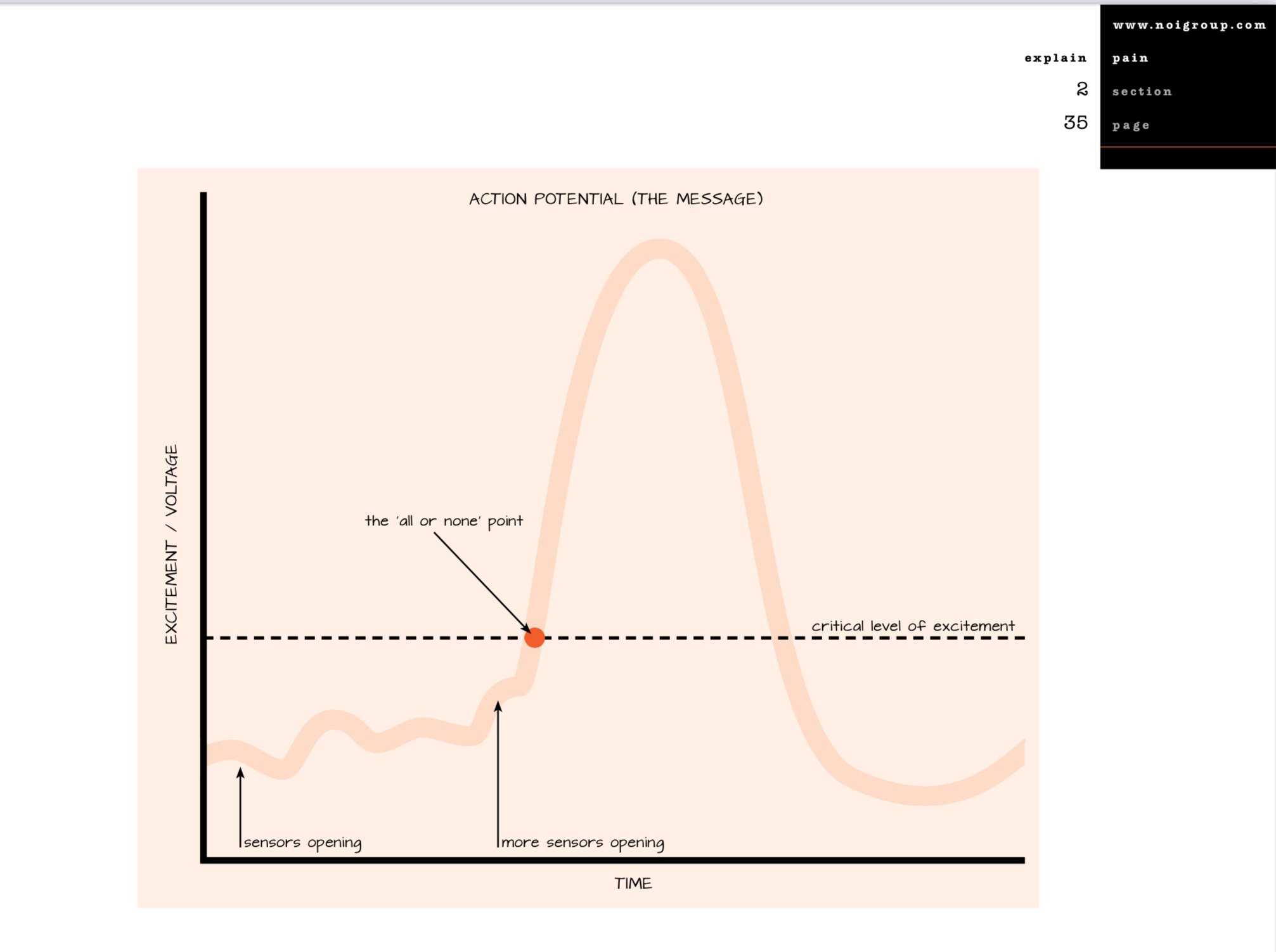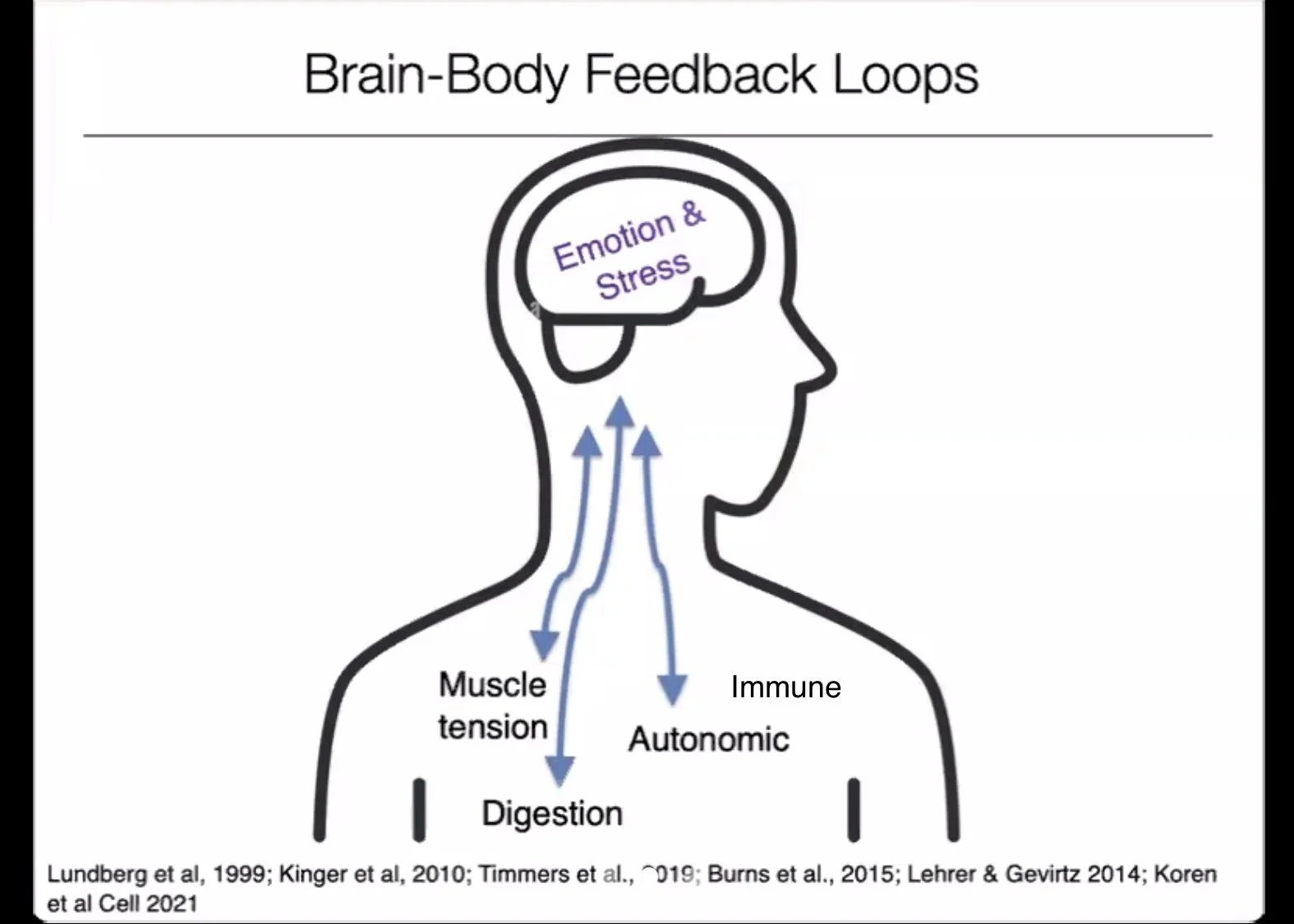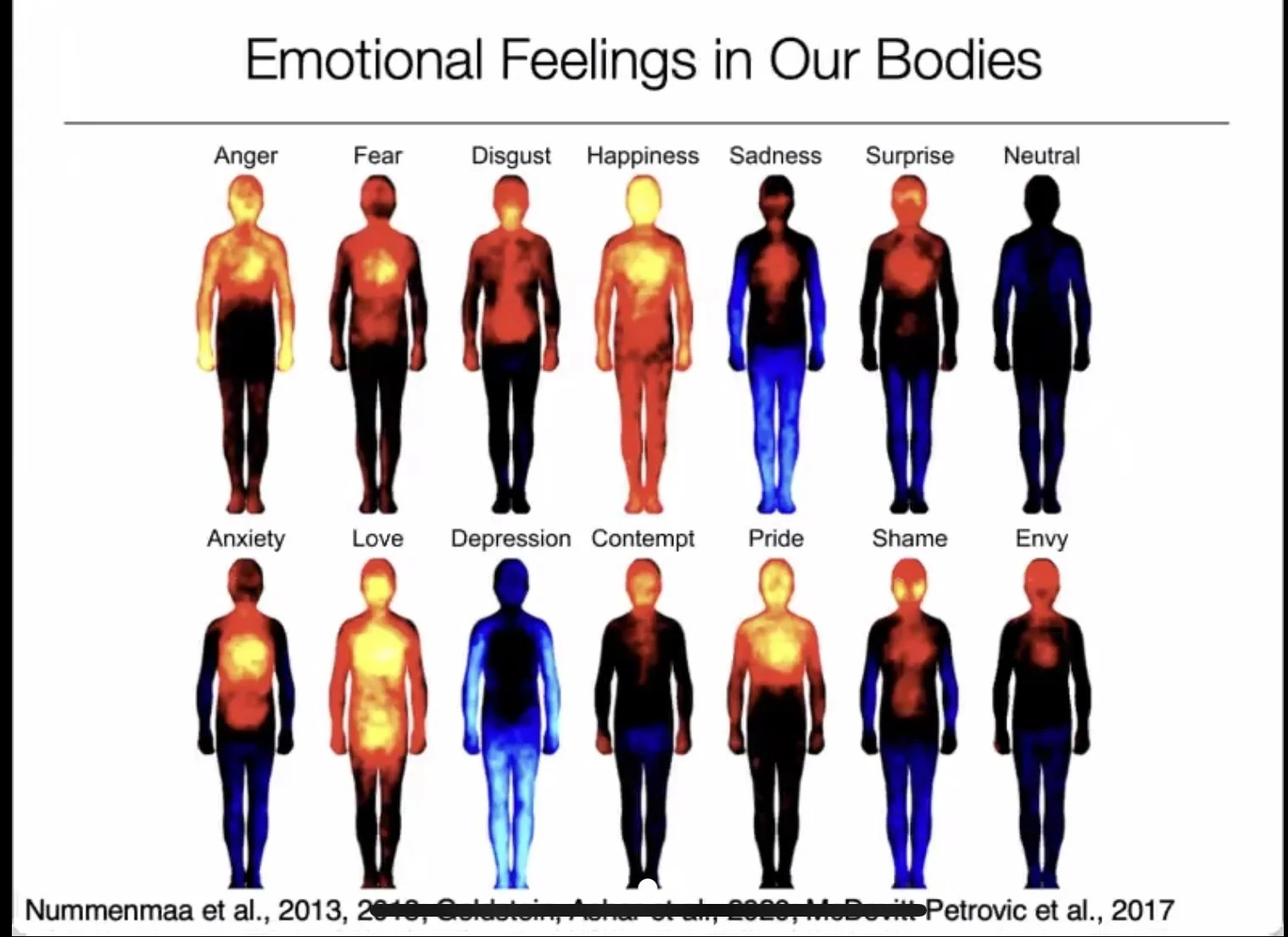Your Road Map to Breaking Free From Chronic Pain
Pain does not equal tissue damage.
Pain is an alarm system
Pain is an alarm to a sensation from the environment received by the brain that is being interpreted as a threat to your body. At the time of an injury, a subconscious part of the brain will sense tissue irritation/inflammation in an area and signal the sensation of pain to your conscious parts of the brain. As the inflammation/irritation resolves, the pain signal to the conscious levels of the brain stops (note the black arrows in the figure below). It’s a good thing we have pain. It helps us to survive and helps us to not do silly things like touch a hot stove.
Pain is related to your brain’s map of the area
There are many different types of nerves that signal sensation types to the brain. When a sensory nerve gets stimulated , it sends an electrical signal to the spinal cord, and then up to the brain carrying information about the type of stimulation and it’s intensity.
The part of the brain that is in charge of the sensations and movements for the different parts of the body is called the sensorimotor cortex.
From there it is also up to the brain to determine what the sensation is and whether or not it is a threat to the organism and what to do about it.
Pain comes from the brain and is related to how easily a nerve fires
The brain sets the level of stimulation needed to produce a pain response. The brain also sets the level of stimulation of a nerve that is needed to produce a signal to the brain
The brain also sets the level of stimulation for a nerve that is “Safe” And not harmful to you as an organism.
Sometimes the area of the brain that is in charge of our survival (known as the limbic system, where the fight / flight response is) will develop a connection to the area of the brain that is dedicated to the movement control and sensation of the body part. The brain can set the level of stimulation that tips a signal from the environment into pain lower than what is “ normal .” This can happen especially if the incident that caused the pain in an area involved some sort of trauma (either emotional, physical, or both) or happened at the same time as a period of heavy amounts of life stress.
If pain has lasted more than three months, it is mostly likely driven by changes in ‘brain volume control’ than ‘issues with the tissues.’
The brain can perceive a threat with certain movements or activities and give a pain signal even if there is no stress or injury to the tissues anymore. For example, someone can have perfect squatting or lifting form but still feel pain because the brain has learned to signal pain because of a lifting injury many years ago. Sometimes, especially if the pain signal persists for a long time, a learned pattern can form a "rut" in the subconscious brain that needs to be relearned and retrained.
The brain influences muscles, heart rate, breath rate, the digestive system and the immune system
The brain’s perception of the environment, movement, recalling memories or even your emotional state / emotional experiences produces subconsious responses in the body.
Changes in background muscle tone or tension, movement patterns, dysautonomia, autoimmune or IBS symptoms can therefore be impacted by these conditoned loops with your primitive brain. This can over time solidify these loops or “errors” in the system and change your posture control, breathing patterns and movement patterns over stressing and overloading your joints and tissues.
Pain lives in the same area of the brain as emotions.
Emotions have corallary body sensations. If there is a conditoned pain loop, emotional states and pain can often occur at the same time and continue to feed into and perpetuate these loops between the memory, emotional and survival centers and our sensory -motor centers of the brain.
Lowered Nerve Firing Thresholds, Muscle Tension and Immune System Reactivity Can Come From Vagus Nerve Dysfunction
ID 215358768 © Axelkock | Dreamstime.com
This is an oversimplification but in general, the vagus nerve takes information from the environment and organs of the body to the brain. From there the brain processes all of this information relative to whether we are safe to “rest and digest” (parasympathetic) or if there is a threat and we need to “brace, fight or flee” (sympathetic) or our immune system needs to fight off an invader. The vagus nerve then carries that information from the brain to the organs and glands of the body, the connective tissue called fascia and our bigger muscles (not the deep core).
With exposures to chronic stress or history of trauma, the vagus nerve firing thresholds to trigger the shift from fight/flight to rest/digest get set too high. The amount of stimulation should normally trigger the vagus nerve to induce a calming rest/digest state is no longer enough. The “home” state of the nervous system gets retrained to be in fight or flight instead of rest/digest (safety). In other words, the sympathetic nervous system switch gets stuck '“on” and the parasympathetic nervous system switch gets stuck “off.”
An simple test to see if this has happened is if you get more anxious after completing 3-4, 6 second duration exhales. This amount of stimulation should normally trigger the vagus nerve to induce a calming rest/digest state. If it doesn’t, the vagus nerve may have some regulation issues contributing to a chronically over active sympathetic nervous system.
How to begin to move forward:
Learn About Pain Science. Just by consciously learning more and understanding what pain is, where it comes from and how it behaves has been shown in research studies to improve a persons pain experience and begin to re-establish healthy physical activity and movement habits when compared to groups of people who did nothing or just did an exercise program. Here are some resources I recommend to get started. If you’re not up for reading a book, most of these books are available on audiobook. You can also do a search for free podcasts interviews that the authors of these books did on your favorite streaming app.
Mosely explain pain
way out Alan Gordon healing chronic painWhy do I hurt? - a workbook by Adriaan Louw PT PhD
Unlearn your pain by Dr. Howard Schubiner
The body keeps the score David Van Der Kolk
What my bones grow healing from complex PTSD - Stephanie Foo
Strong like water - Aundi KolberThis is the Pain Recovery Program created by Alan Gordon, director of Pain Psych Ctr, who wrote a great book The Way Out. It is a FREE 21-day tutorial that includes a group participation feature.
Pain reprocessing self guided materials: https://www.painreprocessingtherapy.com/free-resources
You can work with Kim’s clinic tested and award winning easy to follow self guided course to restore the breath and rebalance the movement and nervous system. Learn more here!
Podcasts
Ezra Klein’s interview of David Van Der Kolk
Stuck but not broken Poly vagal theory podcast by Justin Sunseri
Episode 45 Best of You Podcast Strong like water
Mount Sinai health podcast the road to resilience
2. Build space around your pain to retrain the threshold. Use the 2 point pain rule to begin to increase your activity level. You can do anything you want a long as you stay within 2 points of your starting level of pain. If pain starts to increase to that point, stop. Rest for 15-20 minutes. If that doesn't work then stop the activity. This concept is called the envelope of function. By respecting the boundary in the "survival brain" you will be able to do more after about 2-3 more tries. Sit with your sensations. Don’t push through. Otherwise your brain will keep turning up the volume to grab your consious brain’s attention.
3. Begin a mindfulness practice focused on breathing and counting your breaths to switch off the “flight/flight” part of your brain. Learning to sit and notice the (often neutral) sensation of your breath can help train your brain to learn to sit with other sesnations that may be unpleasant without reacting, like pain.
Breath Counting 3 minute “brain-body reset” (you tube)
commit to 5-15 minutes a day. Once you get the technique down, try this practice when in a heightened emotional state or when experiencing pain
4. Begin a body scan practice to begin to remap your brain, reframe sensations and to grow a healthy brain-body connection.
Soma Healing 45 minute body scan mediation (you tube)
Commit to 5-15 min a day. Once you get the technique down, try this practice when in a heightened emotional state or when experiencing pain. Notice and observe your sensations without reacting to them emotionally.
Commit to short, small moments of awareness and resetting throughout your day.
small bouts of block practice through the day provides the quickest learning of neural skills and establishing new pathways that are used preferentially over old ones.
5. Begin a regular consistent pain reprocessing practice : https://www.painreprocessingtherapy.com/free-resources
Not all sensations are pain. Give yourself some space, once your sympathetic reaction settles using the breathing techniques to get curious about the sensations. See if there are alternative labels for the sensations you are feeling. Try to use low threat words that are not asscoiated with injury (ie try to avoid burning, stretching, pulling, pressure etc). You can even just label it the generic term “sensation.” Some examples may be “I am sore because I am building strength,” “I am stretching and building flexibility” or “My muscles are engaging and stabilizing me better.” Above all, reassure the primitive survival part of your brain that you are safe and that the involved part of your body is safe.
6. Stimulate your vagus nerve
Some easy and low cost ways to stimulate your vagus neve include:
Massaging the area just outside the opening of your ears
Light neck stroking in a downward motion from back of ear to collar bone,
6 count exhales
Light sternum stroking from the center outward
Listening to binaural beats. This is my favorite one . It is a gentle one to get started with and it has bird sounds in it. Bird sounds = no predators = you’re safe! I have playlist of my other favorites here!
Red light therapy applied to the neck
Humming or singing especially with ears plugged
Treat this list like a menu. These techniques are supported in the research, but not all of them work for everyone across the board. Use the techniques that work best for you.
Kim Burns DPT OCS is a certified Pain Reprocessing Therapist through the Pain Reprocessing Therapy Center.
In person and online pain reprocessing therapy is available! Learn more here!
Try the Balanced Breath Self Guided Workshop!
This workshop is a practical application of pain neuroscience, kinesiology (science of movement) and neuroplasticity research to build a more balanced nervous and movement system by harnessing the power of the breath. Learn more here!








